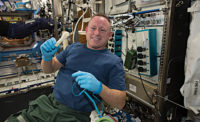NASA spokespeople frequently tell the public that space exploration is not for the faint of heart. But, this type of work is also not for the impatient. Consider, for example, the many scientists, engineers and assemblers who have been working on NASA’s Orion spacecraft for the last decade—even though it won’t be launched on its first exploration mission until Sept. 30, 2018.
The Orion is being designed to be a multipurpose vehicle. It will facilitate human exploration of asteroids and Mars, as well as retrieve crew members or supplies from the International Space Station as needed.
Back on Dec. 5, 2014, the spacecraft successfully completed its first (and only) exploration flight test. The Orion carried no crew on this test, and it will carry no crew on the 2018 mission when the spacecraft spends three weeks in space, including six days in a retrograde orbit around the moon. A second Orion exploration mission (with four-person crew onboard) is planned for sometime between 2021 and 2023.
Thus far, the Orion project has produced several technological and material innovations. One is the development of a prepreg composite resin that replaces traditional titanium on the vehicle’s heat shield (16.5 feet in diameter) and back shell. The shield and shell protect the spacecraft and crew from extreme heat during re-entry.
Made by TenCate Advanced Composites North America, the resin is lighter and costs less than titanium, and it can be used to fabricate large pressure chambers. A prepreg composite resin features a reinforcement fiber that’s pre-impregnated with a thermoplastic or thermoset resin matrix in a specified ratio. This type of composite material cures under high temperatures and pressures.
Developing the final resin involved testing thousands of small resin pieces in environments that simulated a ballistic re-entry from a lunar mission. Tests verified that the thermal insulator on the outside of the composite material can be thinner than titanium due to its higher temperature capability, resulting in improved mass optimization.
The resin costs about as much as a standard aerospace composite, but it has a much higher temperature threshold than the typical 200 to 300 F, notes Colin Sipe, manager of the Orion upper aeroshell system at Lockheed Martin Space Systems Co. Lockheed Martin is the prime contractor on the Orion project, and its thermal protection group worked closely with TenCate engineers to create the heat shield and back shell.
Sipe says the resin also enables simpler and more efficient manufacturing techniques compared to other high-temperature resin systems. As a result, it can be used in aircraft, automobiles and heavy vehicles, as well as launch vehicles, payload fairings (spacecraft nose cones) and re-entry vehicles such as ballistic missiles.
“The material is particularly well-suited [for] any high-temperature location on a vehicle, such as near the engine, inlets, the exhaust [or] main structures,” says Sipe. “Its uses [are] really limited to the designer’s
imagination.”
Besides aerospace applications, TenCate’s prepreg composites are used extensively in automotive products, medical equipment and antiballistics. For more information on prepreg composite resins, call 408-776-0700 or visit www.tencateadvancedcomposites.com.








